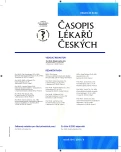Chronic heart failure
Authors:
Jaromír Hradec
Authors place of work:
III. interní klinika 1. LF UK a VFN, Praha
Published in the journal:
Čas. Lék. čes. 2015; 154: 260-268
Category:
Přehledový článek
Summary
Incidence of chronic heart failure (HF) is increasing steadily in all developed countries, predominantly due to population ageing. The prevalence of HF in population is 1–2%, reaching up to 10% in higher age categories. At present HF is classified according to left ventricular ejection fraction (EF) value to HF with reduced EF (formerly systolic HF) and HF with preserved EF (formerly diastolic HF). Coronary artery disease dominates in the aetiology of HF with reduced EF (about 70%), especially status post myocardial infarction. Pathophysiology of HF with preserved EF is very complex and still not fully understood. Multiple comorbidities play an important role, especially hypertension and diabetes mellitus. HF with preserved EF represents about half of all HF cases and its rate is slowly increasing. Morbidity expressed as hospitalization rate is comparable in patients with both types of HF, whereas mortality is a little bit lower in patients with HF with preserved EF. But in patients with HF and preserved EF the prevailing causes of both, the hospitalizations and the deaths are non-cardiovascular.
Diagnosis of HF is relatively simple in fully manifested cases, but it could be a problem in milder forms especially of the HF with preserved EF in elderly patients with multiple comorbidities. For the definite diagnosis of HF the patient has to have typical symptoms and clinical signs as well as objectively documented left ventricular dysfunction, usually by echocardiography. According to the EF value the type of HF is determined. In HF with preserved EF an evidence of a structural heart impairment and/or left ventricular diastolic dysfunction is also necessary. Plasma levels of natriuretic peptides could be helpful for determination of correct diagnosis, particularly in untreated patients. Basic examination of patients with suspected HF is completed by ECG and some laboratory parameters (e.g. renal function, ions, red blood count).
Treatment of HF with reduced EF is based on evidence from many clinical trials. It is complex and consists on non-pharmacological interventions, pharmacotherapy (ACE inhibitors, sartans, betablockers, mineralocortikoid receptor blockers, in specific situations also ivabradine and digoxin), surgery and devices. There is no evidence-based treatment for HF with preserved EF, therefore it still remains empiric.
Keywords:
chronic heart failure – heart failure with reduced ejection fraction – heart failure with preserved ejection fraction – natriuretic peptides
Zdroje
1. McMurray JV, Adamopoulos S, Anker S, et al. ESC Guidelines for the diagnosis and treatment of acute and chronic heart failure 2012. The Task Force for the Diagnosis and Treatment of Acute and Chronic Heart Failure 2012 of the European Society of Cardiology. Developed in collaboration with the Heart Failure Association (HFA) of the ESC. Eur Heart J 2012; 33 : 1787–1847.
2. Hradec J, Vítovec J, Špinar J. Souhrn Doporučených postupů ESC pro diagnostiku a léčbu akutního a chronického srdečního selhání – 2012. Připraven Českou kardiologickou společností. Cor Vasa 2013; 55 : 33–48; event. Cor et Vasa 2013; 55: e25–e40.
3. Gregorová Z, Meluzín J, Špinarová L. Co je nového v srdečním selhání se zachovalou ejekční frakcí levé komory za posledních 5 let? Vnitř Lék 2014; 60 : 586–594.
4. Hradec J. Diagnóza psaná klínovým písmem – editorial. Vnitř Lék 2014; 60 : 553–554.
5. Owan TE, Hodge DO, Herges RM, et al. Trends in prevalence and outcomes of heart failure with preserved ejection fraction. N Engl J Med 2006; 355 : 251–259.
6. Komajda M, Lam CSP. Heart failure with preserved ejection fraction: a Clinical dilemma. Eur Heart J 2014; 35 : 1022–1032.
7. McDonagh TA, Morrison CE, Lawrence A, et al. Symptomatic and asymptomatic left-ventricular systolic dysfunction in an urban population. Lancet 1997; 350 : 829–833.
8. Cleland CHF, Tendera M, Adamus J, et al. The perindopril in elderly people with chronic heart failure (PEP-CHF) study. Eur Heart J 2006; 27 : 2338–2345.
9. Yusuf S, Pfeffer MA, Svedberg K, et al. Effects of candesartan in patients with chronic heart failure and preserved left/ventricular ejection fraction: the CHARM – Preserved trial. Lancet 2003; 362 : 777–781.
10. Massie BM, Carson PE, McMurray JJ, et al. Irbesartan in patients with heart failure and preserved ejection fraction. N Engl J Med 2008; 359 : 2456–2467.
11. Edelmann F, Wachter R, Schmidt AG, et al. Effect of spironolactone on diastolic function and exercise capacity in patients with heart failure with preserved ejection fraction: the Aldo-DHF randomized controlled trial. JAMA 2013; 309 : 781–791.
12. Pitt B, Pfeffer MA, Assmann SF, et al. Spironolactone for heart failure with preserved ejection fraction. N Engl J Med 2014; 370 : 1383–1392.
13. Krupička J, Janota T, Hradec J. Natriuretické peptidy u srdečního selhání. Cor Vasa 2013; 55 : 470–476.
Štítky
Adiktológia Alergológia a imunológia Angiológia Audiológia a foniatria Biochémia Dermatológia Detská gastroenterológia Detská chirurgia Detská kardiológia Detská neurológia Detská otorinolaryngológia Detská psychiatria Detská reumatológia Diabetológia Farmácia Chirurgia cievna Algeziológia Dentální hygienistkaČlánok vyšiel v časopise
Časopis lékařů českých

- Metamizol jako analgetikum první volby: kdy, pro koho, jak a proč?
- Parazitičtí červi v terapii Crohnovy choroby a dalších zánětlivých autoimunitních onemocnění
- Fixní kombinace paracetamol/kodein nabízí synergické analgetické účinky
- Kombinace metamizol/paracetamol v léčbě pooperační bolesti u zákroků v rámci jednodenní chirurgie
- Tramadol a paracetamol v tlumení poextrakční bolesti
Najčítanejšie v tomto čísle
- Výšková nemoc
- Nekardiální plicní edém, syndrom akutní dechové tísně
- Chronické srdeční selhání
- Analýza vztahu sérových hladin párů těžkých/lehkých řetězců imunoglobulinu (Hevylite™) k výsledkům standardní gelové elektroforézy a nefelometrického vyšetření bílkovin séra při diagnóze mnohočetného myelomu
